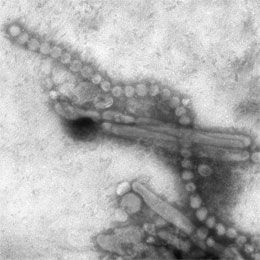New H7N9 avian influenza A virus concerns health experts
Health officials in China are reporting 131 cases of human infection with avian influenza A (H7N9) including 32 deaths as of May 8.
 Avian influenza is a disease of wild birds and domesticated poultry. Currently, many sub-types of Type A influenza virus exist. This is the first time, however, that subtype H7N9 infections have been discovered in humans and people lack immunity to this particular strain of influenza. Because of the immunity issue, experts note there is a possibility this virus could cause a pandemic.
Avian influenza is a disease of wild birds and domesticated poultry. Currently, many sub-types of Type A influenza virus exist. This is the first time, however, that subtype H7N9 infections have been discovered in humans and people lack immunity to this particular strain of influenza. Because of the immunity issue, experts note there is a possibility this virus could cause a pandemic.
Photo at right: Influenza A (H7N9) as viewed through an electron microscope. Both filaments and spheres are observed in this photo. Photo by : CDC / Cynthia S. Goldsmith and Thomas Rowe.
As influenza viruses constantly change and mutate, the World Health Organization (WHO) and other health agencies are carefully investigating the situation in China. Family members and others who have been in close contact with infected individuals are now being closely monitored for signs of infection. Authorities in affected areas have implemented numerous prevention and control measures. Investigations are ongoing to determine the sources of infection. Until a positive identification of the source has occurred and effective control measures are in place, officials suspect new cases of human infection will continue to occur.
Human infections with the many existing subtypes of avian influenza are rare and generally the result of bird-to-human contact. With past outbreaks of avian influenza viruses, human-to-human spread occurred on a limited basis. At this point, with the H7N9 strain there seems to be no evidence yet of sustained human-to-human transmission. However, the Centers for Disease Control and Prevention (CDC) did issue a warning in late April that H7N9 appeared to be more easily transmitted than previous avian influenza strains such as H5N1, commonly known as “bird flu.” That is one factor that has caused concern among health experts.
The WHO and CDC continue to post updates online as new information is received. Though the CDC has not issued any recommendation to avoid travel to China at this time, it does offer practical suggestions for those individuals who will be visiting China. As no vaccine has been developed good hand hygiene and food safety practices are of the utmost importance. Avoid contact with animals, especially live bird or poultry markets. Only consume meat and poultry that is fully cooked. Eggs should be hard-boiled or at minimum cooked to the point that the yolk is not runny. The CDC advises against eating food from street vendors and avoiding any dish or drink that includes animal blood.
Visit the Michigan State University Extension website for additional food safety guidelines.
The CDC also recommends travelers to areas where confirmed cases of human infection by H7N9 has occurred wash hands often with soap and water or hand sanitizer that contains at least 60 percent alcohol. If you sneeze or cough, remember to cover your mouth and nose with a tissue or your sleeve. Avoid touching your eyes, nose, or mouth. If you must do so, make sure your hands are clean. If possible, avoid close contact with individuals who are infected. This includes kissing, hugging, or sharing eating utensils and cups.
Another resource readers might find helpful is the Extension Disaster Education Network (EDEN). Their website includes a page devoted exclusively to H7N9. The page is updated as new information becomes available, offering a variety of educational materials including a one-page fact sheet, a recording of their recent H7N9 webinar and the Powerpoint slides for that presentation. Links to health organizations including WHO, CDC, and the University of Minnesota’s Center for Infectious Disease Research & Policy (CIDRAP) are provided.
Readers can also keep apprised of the developing H7N9 situation by visiting eXtension.org. This is an online collaboration of land grant universities including MSU Extension. Information about a wide variety of topics can be obtained through articles posted on their website.



 Print
Print Email
Email




